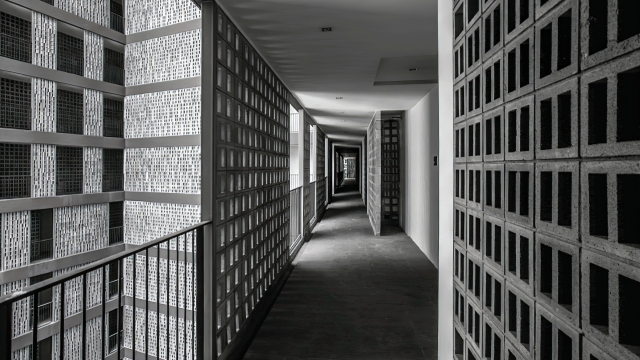Breathing Easy: Unleashing the Power of Ventilation Blocks
When it comes to creating functional and aesthetically pleasing outdoor spaces, ventilation blocks can play a crucial role. These versatile concrete pavers, also known as CMUs (concrete masonry units), offer a range of benefits that extend beyond their basic function. From providing airflow and drainage to offering support for railing systems and retaining wall systems, ventilation blocks have become an essential component in the world of precast concrete civil products.
One of the key advantages of ventilation blocks is their ability to promote proper air circulation. These blocks are designed with precise perforations and gaps that allow air to flow freely, refreshing the atmosphere and ensuring a comfortable environment. Whether used in landscaping projects, commercial buildings, or public spaces, ventilation blocks offer a seamless integration of function and design.
In addition to their ventilation properties, these concrete pavers also provide excellent support for various structures. Railing systems can be easily installed, offering safety and style to elevated areas such as balconies or staircases. Moreover, ventilation blocks serve as a stable foundation for retaining wall systems, ensuring the structural integrity of terraced landscapes and preventing erosion.
Alongside their practical applications, ventilation blocks also excel in water management. With their well-designed perforations, these blocks effectively drain excess water, preventing the accumulation of stagnant water which can lead to various issues. By incorporating drainage systems that are seamlessly integrated with the surrounding pavement, ventilation blocks contribute to a more sustainable and visually appealing environment.
Finally, ventilation blocks are also commonly used as drain covers. These blocks serve as a protective barrier for underground drainage systems, preventing debris and other unwanted materials from clogging the pipes. With their durability and strength, ventilation blocks offer a reliable solution to maintain the functionality of drainage systems while ensuring easy access for maintenance purposes.
All in all, ventilation blocks have transformed the way we approach outdoor construction and design. From their ventilation and drainage properties to their support for railing and retaining wall systems, these concrete pavers offer a perfect balance of function and aesthetics. With their practicality and versatility, ventilation blocks have become an essential component in creating sustainable and visually appealing outdoor spaces.
Benefits of Ventilation Blocks
Ventilation blocks, also known as concrete pavers or CMUs (Concrete Masonry Units), offer a range of benefits that make them a popular choice in the construction industry. These versatile blocks can be used in various applications, including railing systems, precast concrete civil products, retaining wall systems, and drain covers. In this section, we will explore some of the key advantages of using ventilation blocks.
-
Improved Air Circulation: One of the primary benefits of ventilation blocks is their ability to enhance air circulation within a structure. These blocks are manufactured with strategically placed holes or slots, allowing air to flow freely. This can help prevent the build-up of stale air, dampness, and odors, making the environment healthier and more comfortable.
-
Thermal Insulation: Ventilation blocks offer excellent thermal insulation properties, contributing to energy efficiency in buildings. The air pockets created by the hollow spaces help to reduce heat transmission, keeping the interior cooler in hot climates and minimizing the need for excessive air conditioning. In colder regions, the insulation provided by these blocks helps retain warmth, reducing heating requirements.
-
Structural Strength and Durability: Despite their intricate design, ventilation blocks are built to be robust and durable. Made from high-quality materials, such as reinforced concrete, these blocks can withstand heavy loads and provide long-lasting structural support. Their solid construction ensures stability, making them ideal for various construction projects, including retaining walls and railing systems.
By harnessing the power of ventilation blocks, architects and builders can enhance the performance and resilience of their structures while improving the overall living or working environment. The benefits of using ventilation blocks extend beyond aesthetics, adding value to any construction project.
Applications of Precast Concrete Civil Products
In addition to ventilation blocks, precast concrete civil products offer a wide range of applications in various construction projects. From concrete pavers and CMUs to railing systems and drain covers, these precast products provide durability and versatility in the built environment.
One common application of precast concrete civil products is in the construction of retaining wall systems. These precast blocks are designed to provide strength and stability to support earth loads and prevent soil erosion. With their interlocking design, retaining wall systems made from precast concrete components offer ease of installation and the flexibility to adapt to different terrain conditions.
Another significant use of precast concrete civil products is in the creation of stylish and functional railing systems. Whether for residential or commercial projects, precast concrete railings provide a secure and aesthetically pleasing solution. These durable railings can be designed to complement various architectural styles, enhancing the overall appearance and safety of public spaces.
Lastly, precast concrete drain covers are widely utilized to ensure effective stormwater management and prevent blockages in drainage systems. These precast components offer a robust solution, capable of withstanding heavy loads and providing easy access for maintenance purposes. The use of precast drain covers eliminates the need for on-site fabrication, saving time and costs during construction.
By embracing the use of precast concrete civil products, construction professionals can tap into their vast applications. Whether for retaining wall systems, railing systems, or stormwater management, these versatile and durable products play a vital role in ensuring the longevity and functionality of various construction projects.
Innovations in Retaining Wall Systems

Retaining wall systems have undergone significant advancements in recent years, revolutionizing the field of construction and civil engineering. These innovative structures play a crucial role in providing stability and support to various landscapes, while also offering aesthetic appeal. Ventilation blocks, in particular, have emerged as a game-changer within the realm of retaining wall systems.
Traditionally, concrete pavers or CMUs (Concrete Masonry Units) were widely used in constructing retaining walls. However, with the introduction of ventilation blocks, a whole new dimension of possibilities has opened up. These blocks, also known as precast concrete civil products, offer a breath of fresh air, quite literally. Incorporating strategically placed perforations, they allow for enhanced airflow, preventing the buildup of moisture and reducing the risk of damage caused by water seepage.
Moreover, ventilation blocks offer versatility in design and functionality. Manufacturers have introduced various styles and patterns, allowing architects and designers to create visually appealing retaining walls that seamlessly blend with their surroundings. These blocks can also be integrated with railing systems, providing added safety and protection in areas where retaining walls are used for landscape elevation.
In addition to their aesthetic and functional qualities, ventilation blocks also serve practical purposes. They can be utilized as drain covers, allowing for efficient water drainage and preventing the accumulation of water within the retaining wall system. This helps to maintain the structural integrity of the wall and prolong its lifespan.
In conclusion, ventilation blocks have revolutionized the field of retaining wall systems by offering innovative design options, improved airflow, and practical functionality. With their ability to enhance stability, prevent moisture buildup, and provide effective drainage, these blocks have become an indispensable component in modern construction. As the construction industry continues to evolve, it is exciting to see how ventilation blocks will further contribute to the advancement of retaining wall systems.



